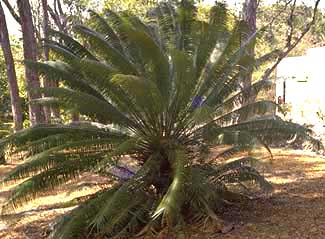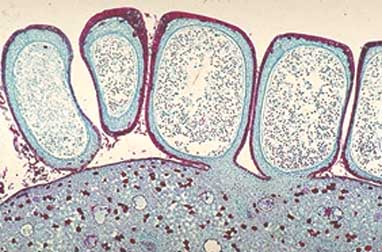| The cycads are ancient gymnosperms which were at their peak in the Jurassic, the "Age of the Dinosaurs", about 150 million years ago. The cycads comprise some 185 species in 11 genera, some native to the Caribbean. Several species of Zamia are native to the Greater Antilles, the Bahamas and Florida. There is also the genus Microcycas (with one species) which is known only from Cuba. |
 |
Cycads
The cycad at left is Cycas circinalis, the False Sago Palm, native to Asia. It is widely cultivated throughout the Caribbean, especially in churchyards. It is vegetatively propagated and certainly in Barbados all the plants seem to be female! |
A virtual tour of the UGA Cycad Collection provides a good introduction to this group.
| Male plants produce male cones which are clusters of microsporophylls each bearing
microsporangia containing microspores (pollen). |
 |
 |
| Cycas male cones | male cone with 2 microsporophylls removed |
 |
 Biodisc photomicrograph |
| microsporophyll showing microsporangia on surface | C.S. microsporophyll & microsporangia |
| Megasporophyll of Cycas with developing seed. Note the other
aborted ovules.
|
|
| In Cycas, megaporophylls are not grouped into cones but occur in a ring around the shoot apex. |  |
| Most other cycads, however, have both male and female cones (see right). |  |
 |
integument micropyle megasporangium archegoium female gametophyte |
Cycad cones generate heat which may aid in the
release of insect-attracting odours. It seems as though small insects such as beetles
serve as the pollinators. The pollen grain (microspore) lodges in the water-filled micropyle and is drawn into the pollen chamber as the water evaporates. |
| tube generative
prothallial cell cell cell |
The pollen grain is made up of three cells (left). | Cycads, unlike other seed plants, have motile sperm. These are large, up to 300 Ám in size. |
| It germinates, the tube nucleus entering the pollen tube which grows through and parasitizes the megasporangium. The generative cell ultimately forms multiflagellate sperm cells. These swim down the tube, enter the archegonium and one fertilizes the egg. An embryo develops from this initially by free nuclear division. |  |
| Cycad seeds are several cm across, often brightly coloured, and most rely on large animals to aid in dispersal. In its natural habitat in Asia, Cycas circinalis is coastal. Its seeds have a spongy layer giving them buoyancy and allowing for dispersal by the sea. |
| The starchy material in the trunks of cycads, termed sago, can be eaten in times of hardship but the main economic importance of cycads is their horticultural appeal. Some cycads are rather rare and unfortunately this fuels even greater demand for these species from collectors (see Lodge, 1993). Trade in all cycad species is strictly regulated by the Convention on International Trade in Endangered Species of Wild Flora & Fauna (CITES). The trade in cycads involves millions of plants and poaching is a serious problem. |
| Fairchild Tropical Garden in Miami has
probably the best collection of cycads in the region. You can see other members of this interesting plant group at sites maintained by the Cycad Society and the Palm & Cycad Societies of Australia &.Palm & Cycad Societies ofFlorida. |
Click here for yet more information on cycads.
| . | In summary: |
| Like all seed plants, the sporophyte is the dominant generation in the cycads. It is typically a pithy trunked plant with large pinnate leaves. | |
| Cycads are all dioecious with microsporophylls always grouped into cones (megasporophylls also form cones except in Cycas) | |
| The gametophyte has been internalized (endospory) and reduced to a single prothallial cell in the pollen grain and a few cells within the ovule. | |
| The large motile sperm cells of cycads are unusual for a seed plant. |
| Would you
like to look at some sample questions on this part of the course? If so, click the button. |
![]() .
.
.